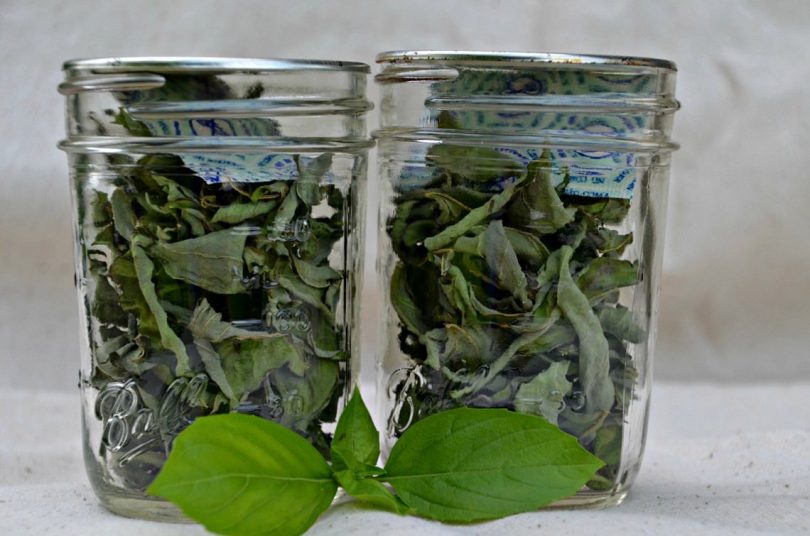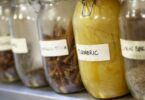Find out, what are the easiest methods of drying basil at home!
You may be wondering where classic Italian dishes such as pizza, pasta, and salads get their distinctive “kick” from.
Yes, that subtle peppery, slightly sweet yet savory and a little bit minty flavor could be very well attributed to a humble culinary herb called basil.
Before we dig into different methods of drying basil, let’s see what’s good in basil and how you should grow and harvest basil.
Basil – the all-around herb
Basil (Ocimum basilicum), also known as St. Joseph’s wort or great basil, belongs to the mint family. There are several varieties including Thai basil, holy basil, lemon basil, but perhaps the most popular and typically used is the sweet basil.
Basil is an annual herb that grows best in hot and dry conditions, and it is cultivated in many countries around the world. It is quite sensitive to cold, which is why you usually see it in the southern regions of Europe, Southern US states, Northern parts of Australia, New Zealand, and as well as in Southeast Asia.
This herb is sought after by many chefs due to the unique flavor it imparts to a wide variety of dishes. Italian dishes are not the only ones that use basil extensively, this herb is also a staple in various Thai, Indonesian and Vietnamese cuisine.
But did you know that basil besides its culinary uses, this herb is rich in vitamin A, Vitamin C, magnesium, iron, potassium and calcium? Not only that, due to its relatively high content of polyphenolic compounds such as flavonoids and anthocyanins, basil has a great potential in treating numerous health conditions including cancer.
In fact, research from the Swiss Federal Institute of Technology reveals that basil contains (E)-beta-caryophyllene (BCP) which could be beneficial in treating inflammation in the body particularly arthritis and bowel disorders.
Moreover, this herb is also known for its anti-aging, anti-stress and antibacterial properties. Basil restricts the growth of harmful microbes including E. coli, listeria, staphylococcus among many others. Thus, basil does not only impart a distinct peppery and minty flavor in food but also aids in keeping the bad bacteria from thriving in your salad!
Growing and harvesting basil
If you love the taste of basil, growing them in your backyard or keeping a small pot of it on your kitchen windowsill seems like a viable choice.
The basil plant loves the warmth and indirect sunlight, the moment the temperature goes down during the beginning of winter, the plant will start to wither and die. Hence, several chefs, home cooks, herb enthusiasts, and foodies opt to preserve the dried leaves of the plant so they can enjoy its flavor and reap its health benefits all- year round.
Prior to drying basil, the leaves are carefully gathered to prevent bruising. Damaged leaves tend to turn black or brown, and improper handling can release the oil prematurely from the leaves which removes its essential flavor. Leaves are best harvested mid-morning as soon as the dew has evaporated since excess moisture causes mold growth.
Some experts also advise harvesting the leaves before the plant flowers, at the time when the leaves are lush and blooming since the leaves before the plant’s reproductive state has the highest concentration of aromatic compounds responsible for its unique flavor.
Using garden scissors or kitchen shears, cut the young and tender leaf or basil sprigs, discarding any diseased part. When harvesting small quantities, you may lightly pick the leaves from the plant using your hands. Gently inspect the leaves for any pests, yellowing, or spotted leaves. A variety of insects and pests love to feast on the flavorful leaves of the basil plant, so be sure to be on the lookout for them.
SEE ALSO: How to Harvest Fresh Basil for Drying
Common Methods of Drying Basil
1. Air drying
The most traditional and perhaps easiest and most economical way of drying basil is air drying.
This is done by tying a bunch of fresh basil sprigs carefully using a rubber band, twist tie or any available sturdy string.
- Hang them upside down in a warm, well-ventilated, dry area that is away from direct sunlight, and where pests and insects would not be able to “chow” on your drying basil. The optimum temperature in air drying basil is 60 – 80 degrees Fahrenheit (15 – 20 degrees Celsius).
One major drawback of using this method of drying basil is it takes approximately 2 to 4 weeks (depending on the drying condition) for the herb to completely dry up. And if the leaves and parts of the plant were not completely free from moisture prior to this procedure, it might cause mold to grow on the leaves, rendering the basil sprigs useless.
Finding in a suitable place in the house to use in drying basil can also be a challenge. You might not want the herbs to be openly visible as it may disrupt your everyday household activity or too “hidden” that you may completely forget that you are drying basil somewhere in your home.
2. Drying basil in a microwave
Another simple technique of drying basil is by using a microwave. It is perhaps the fastest way of drying basil and preserves a significant amount of its original flavor and aroma. This works best if you require a small amount of dried basil right away and if you have limited space for drying basil sprigs.
In this method…
- You only need to pinch several good-quality leaves from the plant.
- Rinse them to remove any dirt and other impurities from the leaves, and then using a paper towel, gently pat the leaves to remove any excess moisture.
- Place the leaves on a kitchen towel or paper towel placed on top of a microwave-safe container and then turn on the microwave on the highest setting for bouts of 20 – 30 seconds.
- Continue microwaving the leaves in thirty-second bursts until the leaves start to curl and dry. This usually takes 2 to 3 minutes depending on the microwave power setting.
Here is a great tutorial video about how to dry herbs in the microwave.
One advantage of using the microwave in drying basil is that it dries out the leaves but preserves its natural green color and most of the flavor, unlike the other drying techniques.
You only need to be extra cautious when doing this procedure and make sure that the leaves or the paper towel do not catch fire.
3. Sun-drying basil
This method is particularly convenient in areas with a tropical climate, during summer or when drying basil in large quantities.
- Harvested leaves may be placed and spread out on a wire-mesh screen, a clean bed sheet or a drying mat, and then placed under the sun for several days depending on weather conditions.
- You may place several rocks on the mat to weigh it down.
- It is also important to ensure that the wind is calm so as not to blow your basil leaves away.
- You may also need to move the mat several times in the day to ensure that the leaves get the maximum amount of sunlight.
Sun-drying may not be the most convenient way of drying basil but it sure is the most energy-efficient since it only utilizes solar energy throughout the process.
4. Using an oven
Drying basil using an oven is a fairly simple method and usually takes only several hours up to one day to get the desired results.
In this procedure…
- Freshly harvested leaves are washed and placed in a single layer on a roasting pan or a cookie sheet lined with parchment paper and baked at 100 degrees for about 50 minutes.
- Ensure that the temperature is not too high since that could impart a slightly bitter taste to the herb.
- After 50 minutes, turn off the heat and leave basil in the oven for an additional 3 to 4 hours. Check frequently.
SEE ALSO: Drying Basil in the Oven – Easy Step by Step Guide
It is also important to take note that metal darkens the basil leaves, hence, always remember to place a parchment paper or Silpat whenever drying basil on a metal tray.
5. Using food dehydrator
Food dehydrators work by circulating heated air around the food to be dried to make sure that it is evenly dried. This method is not just great for drying herbs like basil, but also for drying and preserving fruits, and vegetables as well.
Using dehydrators for drying basil is one of the most convenient methods and is typically used when you are drying large quantities of basil leaves.
- Arrange the leaves in a single layer and turn the dehydrator on its lowest possible temperature setting.
- The drying process may take up to 4 to 6 hours depending on the moisture content of the leaves and how hot the lowest setting is in your particular food dehydrator.
You may check the equipment’s manual to adjust your settings accordingly.
READ ALSO: 10 Amazing Benefits of Dehydrating Food
How To Store Dried Basil
Dried basil, like most of other herbs and spices, is best preserved by storing them in small airtight containers away from the light.
Freshly dried basil leaves can be stored as whole leaves and only crushed when it is used to preserve the subtle peppery flavor and other aromatic compounds that chefs and food enthusiasts long for.
Others prefer to crush the leaves after drying basil so it can be stored in small jars and then sprinkled on top of food.
LEARN MORE: How to Preserve and Store Dried Basil
There are several methods of drying basil: air drying, sun drying or using the oven, microwave or food dehydrators.
Pick the one that is best suited for the quantity of basil leaves your need, the time it takes to process and of course your own budget and convenience.





